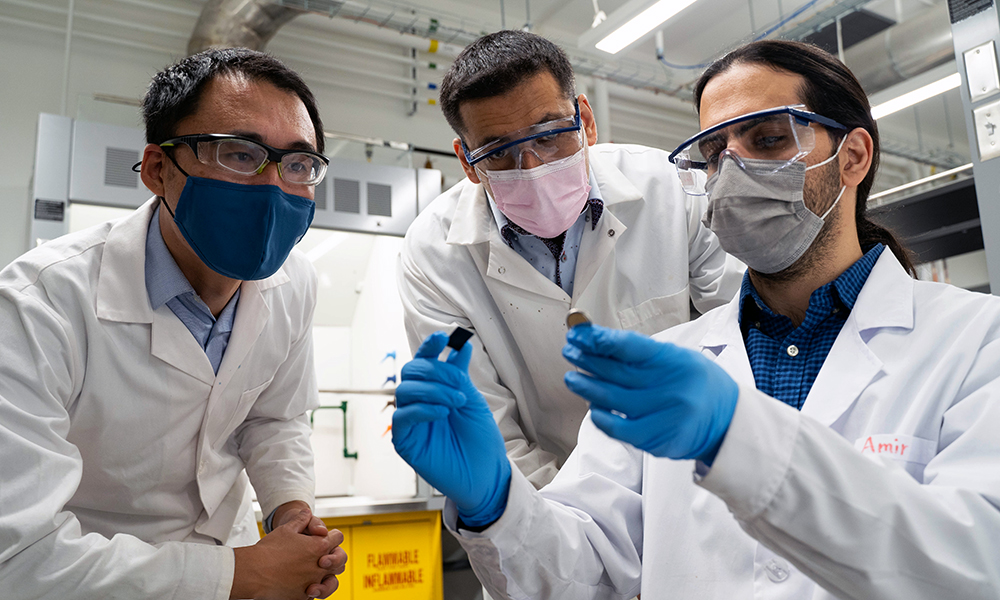
UBCO School of Engineering researchers Mohammad Arjmand, Jian Liu and Amir Ahmadian examine a conductive polymer nanocomposite sample, created from non-recyclable plastic and rubber waste, that can be used for electrical applications.
The life cycle of bright, bouncy tennis balls isn’t long. Depending on the level of play, a tennis ball might be used for three to four hours or even less in professional circuits. And while the ball is only used on a court for a short time, it can sit in a landfill for decades.
Now, researchers at UBC Okanagan’s School of Engineering are collaborating to develop an innovative use for non-recyclable plastic and rubber waste. In fact, these materials, mostly from cars and sporting goods, are emerging as key components in batteries and other energy storage solutions.
“Reusing plastics and rubber waste not only means diverting these products from landfills, but it also creates value-added nanocomposites at a lower cost,” explains Amir Ahmadian, a doctoral student in the Nanomaterials and Polymer Nanocomposites Laboratory at UBC Okanagan.
Tires and many sporting goods are some of the most challenging sources of waste on the planet because not only are they cumbersome, but they take more than 50 to 80 years to decompose.
While researchers at UBC and other universities around the world have been investigating extracting components like carbon from tires, Arjmand and Liu are turning their attention to breaking the materials down into crumbs and developing conductive polymer nanocomposites for electrical applications.
These microscopic materials serve as a filler in polymers that have the added benefit of building a structure that could respond well within energy storage solutions like batteries.
Arjmand, a Canada Research Chair (Tier 2) in Advanced Materials and Polymer Engineering, says the reused waste creates a more efficient product as the crumbled material can be used for the development of electromagnetic shields.
“Even when working at the nanoscale, we still require bonding agents and filler to complete the composite configuration, and these vulcanized crumbs provide a multi-functional foundation,” he says. “Due to the improved conductivity of these materials, they have applications both in batteries and electromagnetic shields.”
From an energy storage perspective, Liu explains, these recycled materials might find potential applications in lithium-ion batteries.
“Previous research has shown that composite filler materials in batteries, specifically lithium-ion batteries, can greatly improve power output,” says Liu, a Principal’s Research Chair in Energy Storage Technologies. “Finding just the right filler attributes has long been the hurdle, and these new recycled nanocomposites offer so many possibilities because their composition can be easily manipulated.”
By using the plastic waste material, Liu says not only are the researchers turning a waste into a value-added product but they can also decrease the amount of polymeric matrix needed to obtain a specific level of electrical conductivity, which has a huge impact on the final cost of the nanocomposite.
“Looking to the future, we may one day see an affordable, reusable, recyclable battery that uses plastic waste material as a value-added product empowering the concept of circular economics,” he adds.
The research was funded through a Natural Sciences and Engineering Research Council of Canada Discovery Grant and published in the journal Polymers.